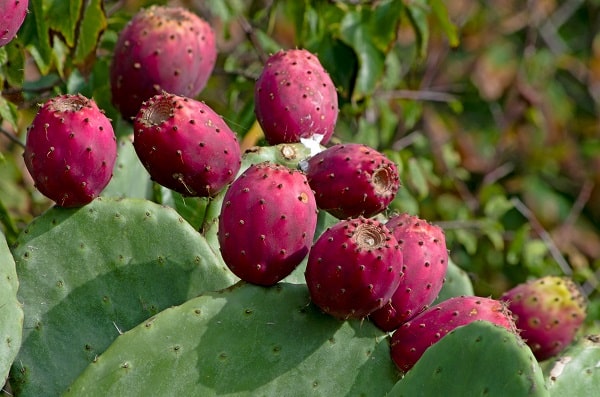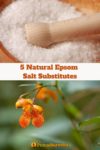No bug-out bag is complete without a packet of Epsom salts. Largely considered to be “the ultimate survivalist’s panacea,” Epsom salts can last for years and has a wide range of uses, from emergency first aid to pest repellant.
We all make mistakes, however, and maybe you left your Epsom salts at home or to have stored them incorrectly, causing them to spill out and cover the contents of your bug-out bag with a smattering of salty white powder.
Suddenly incidents you thought were prepared for, become potentially hazardous. You brush against some poison ivy and, in addition to an irritating rash, you end up with a nasty bacterial infection. With no Epsom salts on hand to relieve the itching, what do you do?
We’re going to take a look at the most common uses of Epsom salts and what you can use as an alternative if your number one remedy isn’t available.
#1 Relieve itching

Epsom salts are well known for their ability to relieve all kinds of skin irritations, including those caused by moths, caterpillars, poison ivy, and other bugs and plants.
Mother Nature generously provides us with various natural remedies for itchy skin. Jewelweed, for instance, is found throughout the USA, so unless you’re trying to survive in Montana or California, it’s one of your best options for alleviating skin irritations.
An attractive plant with orange trumpet-shaped flowers, Jewelweed is also known as Touch-Me-Not because touching its ripe seedpods causes them to explode. Fortunately, an exploding seedpod won’t cause you any harm, so you can safely harvest the parts you need.
Target the hollow stems of the Jewelweed and then slice these open or crush them to gain access to the sticky sap inside. This sap contains a chemical that “neutralizes the urushiol oil contained in poison ivy,” relieving the irritation and preventing the rash from spreading to other parts of the body.
Jewelweed is also an effective treatment for acne, eczema, ringworm, and warts.
#2 Remove splinters

There are several natural drawing agents in the woods and forests of North America, many of which are just as effective as Epsom salts at drawing out splinters and extracting toxins.
In Mexico and the Southern United States, the Prickly Pear cactus grows prolifically. As its name suggests, it’s not a particularly friendly plant with its long, barbed spines and microscopic prickles, known as glochids, so err on the side of caution when harvesting this plant.
The Prickly Pear’s leaves or pads contain a rather gloopy, mucilaginous substance that, while not particularly pleasant to handle, has many medicinal benefits. Similar to Aloe Vera gel, this substance is excellent for drawing out toxins and can be used on minor splinters or more critical snake bites.
Select your pad and carefully remove it from the tree, then cut away the outer, spiny layer, revealing the moist interior. Scoop this out and apply directly to the splinter or bite, using leaves or bandages to hold it in place. Leave the poultice to draw and soothe for around 36 hours and then repeat as necessary.
If you’re stuck in one of the Northern states, where few cacti flourish, you can turn to the other survivalist’s lifesaving powder, activated charcoal, to save your bacon. Knowing how to make an activated charcoal poultice is a critical skill for any self-respecting survivalist. It can be used to treat plant rashes, and mild infections, in addition to being an effective drawing agent.
#3 Sanitise and Disinfect

The abrasive nature of salt makes it ideal for scrubbing cooking pots or even giving your skin a quick exfoliation, making it the perfect substitute for Epsom salts. Table and sea salt are both equally effective at cleansing the skin and for treating areas of dry or flaky skin.
Among the many uses for pine tree sap is its ability to soothe and disinfect wounds. This sticky substance won’t do much for your cooking pots, but it will stick to a wound and accelerate the healing process.
If you want to get your pots squeaky clean and shiny, a mixture of baking soda and vinegar will do the trick quickly and without requiring you to put any extra elbow grease into the process.
#4 Alleviate constipation
Epsom salt can alleviate the discomfort of constipation within 30 minutes, but it’s not the only natural substance with these superpowers. Curly dock grows worldwide and has laxative properties that stimulate the digestive symptoms, relieving mild constipation quickly and effectively.
Flaxseeds are highly nutritious, so well worth considering when you’re buying and making survival food. Whole flax seeds also speed up intestinal movement, relieving constipation and reducing the likelihood of it reoccurring.
Aloe vera is also effective in treating constipation, but you’re unlikely to find it growing wild in North America. A better option would be to hunt down some wild Senna or Cassia, which is native to eastern North America and contains “plant compounds called glycosides, which stimulate the nerves in the gut and help speed up bowel movements.”
You could also strike a yoga pose or perform some simple acupressure, as demonstrated in this video tutorial, to help resolve the problem.
#5 Increase food production
If you’re trying to grow your own food, you’ll no doubt be familiar with the ability Epsom salts have to keep bugs at bay. When sprinkled under your vegetables, it forms a natural, abrasive barrier to crawling insects while giving your plants a bit of a boost.
Although diatomaceous earth isn’t much of a plant-food supplement, it is abrasive enough to keep the creepy crawlies at bay. Sprinkle it on the plants themselves, and it will also help deter ants, slugs, snails, mites, and even rodents.
While diatomaceous earth may not be high on your bug-out bag checklist, it probably ought to be. Not only can it boost your food production, but it offers a host of benefits for your survival food supplies, keeping moisture and mold at bay while deterring bugs. You can also use it to clean your teeth, detoxify your bloodstream and digestive system, and boost your immune system.
Conclusion
If you find yourself in the woods without your Epsom salt, don’t despair. With the information provided here, some basic bushcraft skills, and a little ingenuity, you can find naturally occurring substitutes for all the things you might use Epsom salt.
With one of the best brands of activated charcoal in your bug-out bag and having memorized the 7 most useful trees for survivalists and preppers, you should be able to deal with most emergencies even if you did leave your Epsom salt at home.
Also read – Does epsom salt go bad?


